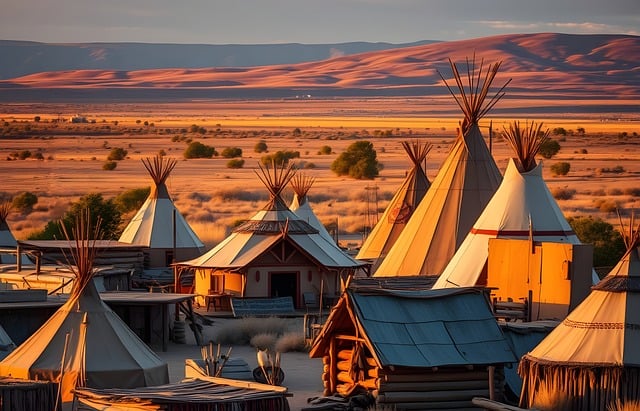Luxury and sustainability used to seem like contradictions, but today, eco-luxury is changing that perception. Travelers no longer have to choose between indulgence and responsibility. The rise of eco-luxury glamping is proving that you can enjoy high-end comfort while still respecting the planet.
What Does Eco-Luxury Mean?
Eco-luxury is all about balancing extravagance with environmental consciousness. It means staying in places that use sustainable materials, conserve resources, and support local communities — all while providing world-class comfort. Whether it’s a safari tent with solar power or a treehouse with organic cotton bedding, eco-luxury travel lets you experience nature without harming it.
What does eco-luxury mean in practice? It’s more than just swapping plastic straws for reusable ones. It involves rethinking how accommodations are built, how they source energy, and how they handle waste. It’s about creating beautiful, immersive experiences while ensuring that future generations can enjoy the same pristine landscapes.
The Shift Toward Sustainable Luxury Travel
What is sustainable luxury travel? It’s travel that offers upscale experiences without compromising the environment. More resorts and glamping sites are adopting eco-friendly practices, like eliminating single-use plastics, using renewable energy, reducing water consumption, and sourcing food locally. Even five-star accommodations are embracing sustainability by integrating eco-conscious designs and conservation efforts.
As demand for sustainability grows, eco-luxury travel is evolving beyond just accommodation. Some destinations offer carbon-neutral experiences, where everything — from transportation to activities — is designed to minimize emissions. Others work closely with Indigenous communities to ensure tourism benefits local people rather than exploiting them. Luxury adventure travel offers the best balance of well-being and adventure, focusing on rejuvenation and wellness.
How Glamping Embodies Eco-Luxury Travel
Glamping has become one of the best ways to explore sustainable luxury travel. It combines the excitement of the outdoors with the comforts of a high-end resort, all while minimizing environmental impact. The best glamping destinations go beyond stylish tents and scenic views — they actively reduce their footprint through eco-conscious design, responsible energy use, and thoughtful waste management.
1. Eco-Friendly Construction
Traditional hotels and resorts often require large-scale construction that disrupts natural habitats. However, glamping sites are designed to blend into their surroundings with minimal impact. Structures may be removable, modular, or built using reclaimed or locally sourced materials. This reduces deforestation and preserves wildlife habitats.
2. Renewable Energy Use
Many high-end glamping destinations now use solar, wind, or hydroelectric power to reduce their reliance on fossil fuels. Some even implement passive heating and cooling techniques to reduce energy consumption. Switching to renewable energy sources supports a carbon-neutral travel experience.
3. Water Conservation and Responsible Waste Management
Water scarcity affects about 10% of people globally. Sustainable luxury travel means being mindful of water use and waste disposal. Many glamping sites incorporate innovative water conservation strategies, like rainwater harvesting and composting toilets. Some also feature eco-showers that use biodegradable products and require less water, protecting local water sources and reducing waste in fragile ecosystems.
4. Supporting Local Communities and Wildlife Conservation
Luxury doesn’t just mean five-star amenities — it also means giving back. Many glamping sites invest in local communities, provide jobs, and fund conservation efforts.
5. Low-Impact, Immersive Nature Experiences
Glamping brings travelers closer to nature without disturbing it. Unlike traditional hotels, which often clear land for development, many glamping sites are set up with minimal disruption to the environment.
6. Sustainable Cuisine and Farm-to-Table Dining
Part of luxury glamping is being mindful of what you eat and where it comes from. Many eco-lodges grow their own organic produce, serve locally sourced meats and seafood, and avoid imported, high-emission foods.
Why It Matters
Eco-luxury glamping isn’t just a trend — it’s a movement toward responsible tourism. Eco-luxury travel means making thoughtful choices and staying at places that respect wildlife, minimize waste, and invest in local economies. Choosing eco-luxury travel means you’re part of an effort to:
- Preserve natural ecosystems by minimizing land disturbance.
- Lessen your carbon footprint by using renewable energy sources.
- Conserve water through rainwater harvesting and eco-friendly systems.
- Minimize waste with zero-waste policies and plastic-free initiatives.
- Support local communities by providing jobs and fair wages.
- Encourage responsible tourism that gives back to the destination.
When done right, eco-luxury travel doesn’t have to be wasteful. Instead, it can be a force for good, protecting natural spaces, supporting communities, and redefining what indulgence looks like.
The Future of Eco-Luxury Glamping
As more travelers seek meaningful and responsible experiences, the future of sustainable luxury travel looks bright. Technological advances, changing consumer values, and stricter environmental regulations drive the industry toward even greener innovations.
Smart Sustainable Lodging
Glamping sites are incorporating smart technology to monitor and reduce energy use. Motion-sensor lighting, automated climate control, and AI-powered water filtration systems help minimize waste while ensuring premium comfort.
Regenerative Travel and Carbon Offsetting
Beyond being sustainable, some glamping facilities focus on regenerative tourism — leaving the environment in better shape than you found it. Some offer carbon offset programs, tree-planting initiatives, and marine conservation projects in which guests can actively participate.
Biophilic and Modular Design
New glamping structures are designed with biophilic architecture, which mimics nature’s patterns and minimizes artificial materials. Prefabricated modular designs also make it easier to dismantle and relocate sites without harming the environment.
The Future of Travel
Glamping is redefining what eco-luxury means by proving that sustainability and indulgence can go hand in hand. You don’t have to sacrifice comfort to be eco-friendly.
Beth Rush is the green wellness editor at Body+Mind. She has more than five years of experience writing and editing articles covering topics like sustainable transit and the importance of green spaces in urban planning. You can find Beth on Twitter @bodymindmag. Subscribe to Body+Mind for more posts by Beth!
Image by Vicki Hamilton






